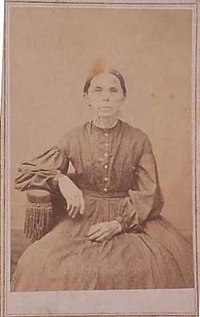Hesba Stretton
| Sarah Smith | |
|---|---|

Sarah Smith
|
|
| Born |
27 July 1832 Wellington, Shropshire, England |
| Died | 8 October 1911 (aged 79) Ham, London, England |
| Pen name | Hesba Stretton |
| Occupation | Writer (novelist) |
| Nationality | English |
| Period | 19th century |
| Genre | Children's literature |
Hesba Stretton was the pen name of Sarah Smith (27 July 1832 – 8 October 1911), an English writer of children's books. She concocted the name from the initials of herself and four surviving siblings and part of the name of a Shropshire village she visited, All Stretton, where her sister Anne owned a house, Caradoc Lodge.
Sarah Smith was the daughter of a bookseller, Benjamin Smith (1793–1878) of Wellington, Shropshire and his wife Anne Bakewell Smith (1798–1842), a noted Methodist. She and her elder sister attended the Old Hall, a school in the town, but were largely self-educated.
About 1867, Sarah Smith moved south to live at Snaresbrook and Loughton near Epping Forest, and at Ham, near Richmond, Surrey.
Smith was one of the most popular Evangelical writers of the 19th century, who used her "Christian principles as a protest against specific social evils in her children's books." Her moral tales and semi-religious stories, chiefly for the young, were printed in huge numbers and often chosen as school and Sunday-school prizes. She became a regular contributor to Household Words and All the Year Round under Charles Dickens's editorship, after her sister had successfully submitted a story of hers without her knowledge. Altogether she wrote more than 40 novels.
The book that won widespread fame for "Hesbah Stretton" was Jessica's First Prayer, first published in the journal Sunday at Home in 1866 and the following year in book form. By the end of the 19th century it had sold at least a million and a half copies. Critic Brian Alderson notes that its sales were "nearly ten times as many as those of Alice in Wonderland." The book gave rise to a genre of stories about homeless children "that successfully combined elements of the sensational novel and the religious tract and helped introduce the image of the poor, urban child into the Victorian social conscious."
...
Wikipedia
